27 Competitive Intelligence Sources to Monitor
By Emily Fenton
Updated September 8, 2025
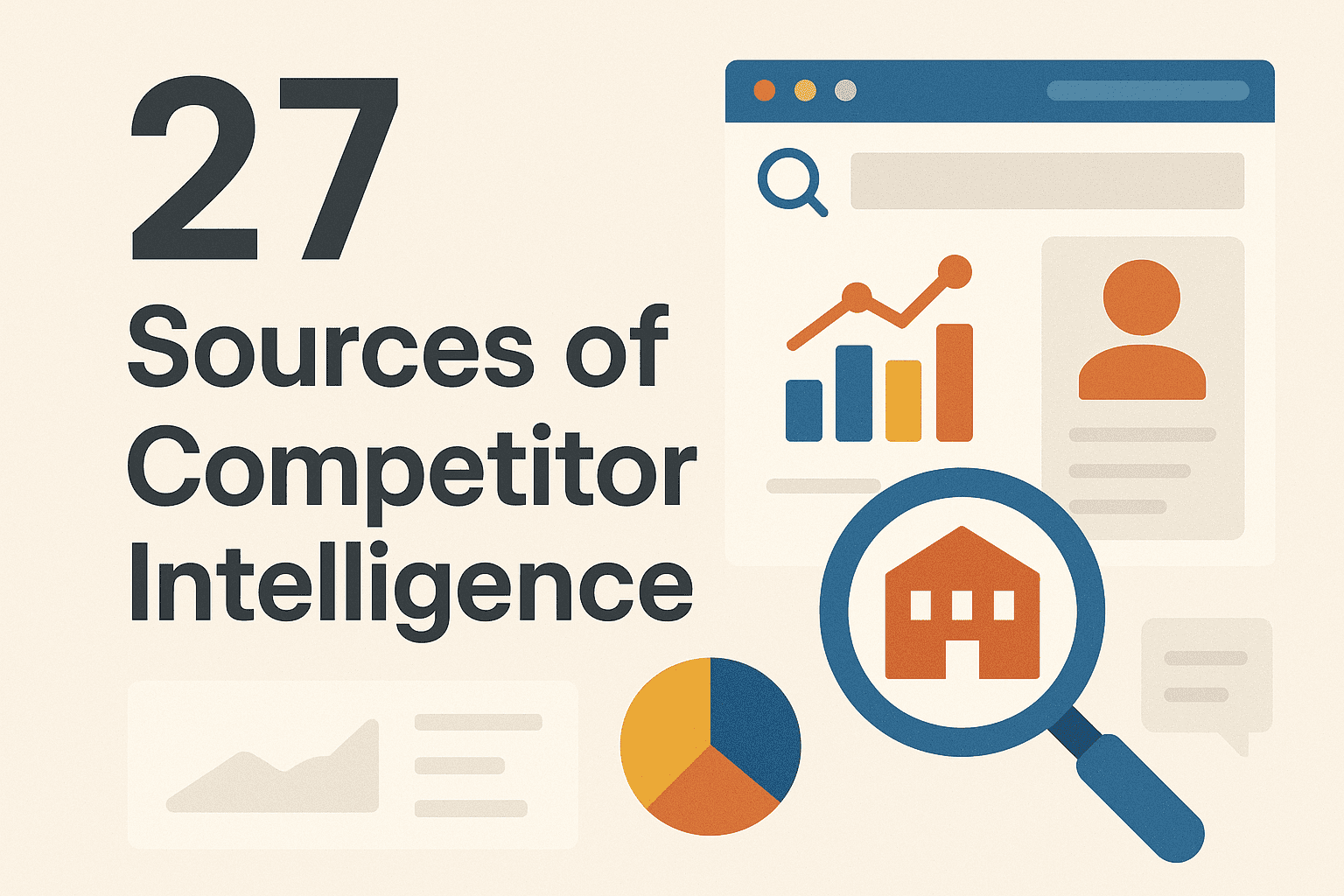
Introduction
When launching your competitive intelligence strategy, where do you even start? Well, once you've identified your competitors, you need to make a plan for how you're going to stay on top of their movements. That means making a list of competitive intelligence sources that you can monitor to find out everything that your competitors are up to.
The best, and most obvious source of competitive intelligence is the internet. As your competitors adjust their strategies, these pivots are almost always eventually revealed online. But where do you look? Which competitive intelligence sources have the power to reveal your competitors' moves?
This article features a list of the top 27 competitive intelligence sources that you should start monitoring today.
Pro tip: While manual monitoring works for 2-3 sources, scaling beyond this requires automation. Tools like Visualping can monitor dozens of sources simultaneously, using AI to filter relevant changes and prevent alert fatigue.

Without further ado, here's our list of the best competitive intelligence sources, starting with key pages and elements on your competitor's website:
Top 27 Competitive Intelligence Sources to Monitor
"Most people monitor a competitor's home page, pricing page, and maybe a product page or two and call it competitor monitoring. Even more people do it manually - spending hours each week browsing multiple competitor sites; often catching moves when it's already too late, or not at all..." - Eric Do Couto, Head of Marketing
1. Home Page
If you're a marketer yourself, you know that a few pages on a business' website are special, critical pages. For an update to be made to these pages, a high bar has to be met. That's why the first page on this list of competitive intelligence sources is your competitor's home page.
Monitor your competitor's home page for updates to their main headline or imagery, new special notices, or even subtle changes to the content lower down the page, such as customer testimonials. You can be sure that the change you are detecting is the result of a careful decision.
2. Pricing Page
If your competitor offers any kind of pricing content on their website, this is the second thing to keep a close eye on. Especially in software sales, the pricing page tends to be one of those "special" pages that is created with a ton of careful thought, and only updated when something important is changing at your competitor. These pages are typically dense with detail so, Visualping is super helpful for catching a small change you might not have noticed if checking manually.

3. Navigation
Like the home page or pricing page, a company's navigation only changes when they are trying to direct significant attention to something important. Be sure to use Visualping's advanced features to reveal navigation elements and monitor only the specific dropdown(s) you care about.
4. Executive Team Page
Most companies like to feature their executive team on their website; this is an excellent page to keep an eye on. The "team page" will reveal to you when there's a key departure, or a key hire. These updates can tell you a lot about where your competitors are feeling changes are warranted, or bigger investments are needed.
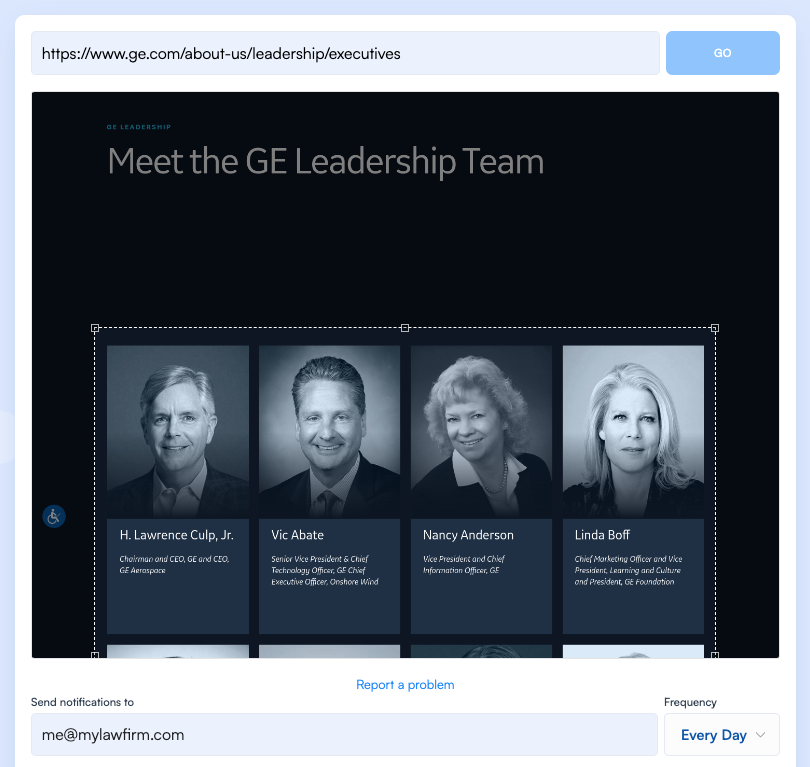
5. Press release page
If your competitors have a press release page, it should be a no-brainer to monitor it for corporate updates. This is where you might learn about awards, partnerships, releases, and corporate development activities. Press pages will tell you a lot about the bets your competitor is making to try and stand out.
6. Blog roll
A company's blog is the best source for an understanding of where they're currently focusing their marketing resources. You'll notice from the style, form, and content of their posts what they want their customers and the market to know about their business.
7. Robots.txt
One of my favorite things to check on a competitor's website is their robots.txt file. This file is a special URL that almost every website has, and it tells automated bots what they should (or shouldn't) be visiting on a competitor's site. Try it out: enter any website, followed by "/robots.txt" (for example, visualping.io/robots.txt). You'll see some interesting subfolders that might be worth checking out, especially the ones that your competitor is trying to hide from bots! You'll also likely find the website's sitemap, which is the next entry on our list:
8. Sitemap file(s)
If you want to know whenever your competitor creates a new page on their site, try finding and monitoring their sitemap file. You can usually find the URL in their robots.txt file (above). The sitemap is a technical list of all the pages on a website, and it serves to help bots, like Google, navigate and find pages. Whenever a new, important page is published, it should show up here. If you're really lucky, their sitemaps will be organized by type of content; so you can choose which sorts of pages you want to watch.

9. Release notes/"what's new" page
If you're in software, the "what's new" page will contain a nice running log of updates to a company's products. How nice of your competitors to put all of their developments in one place!
10. Careers page
Similar to the executive team page, your competitors' job boards will tell you a lot about the investments they're making in their business.
11. Status page
When your competitors are experiencing downtime, they often post about it in a specific, (somewhat hidden) location. Use Visualping's high-frequency monitoring to get alerted within five minutes of an update to this page.
12. Investor relations/news releases
If your competitor is a publicly traded company (or owned by a publicly traded company), monitor their investor section for new releases. You'll learn about significant insider stock trades and get notified of their quarterly financial filings.
13. Key conversion pages
Monitor your competitors' key "conversion" pages for updates. The exact nature of this page will depend on what type of business you're in; it could be a shopping cart page, a sign up page, or a contact us page. By monitoring this page, you'll pick up the small tweaks they are making to improve the user experience and position their offering at a critical destination on their website.
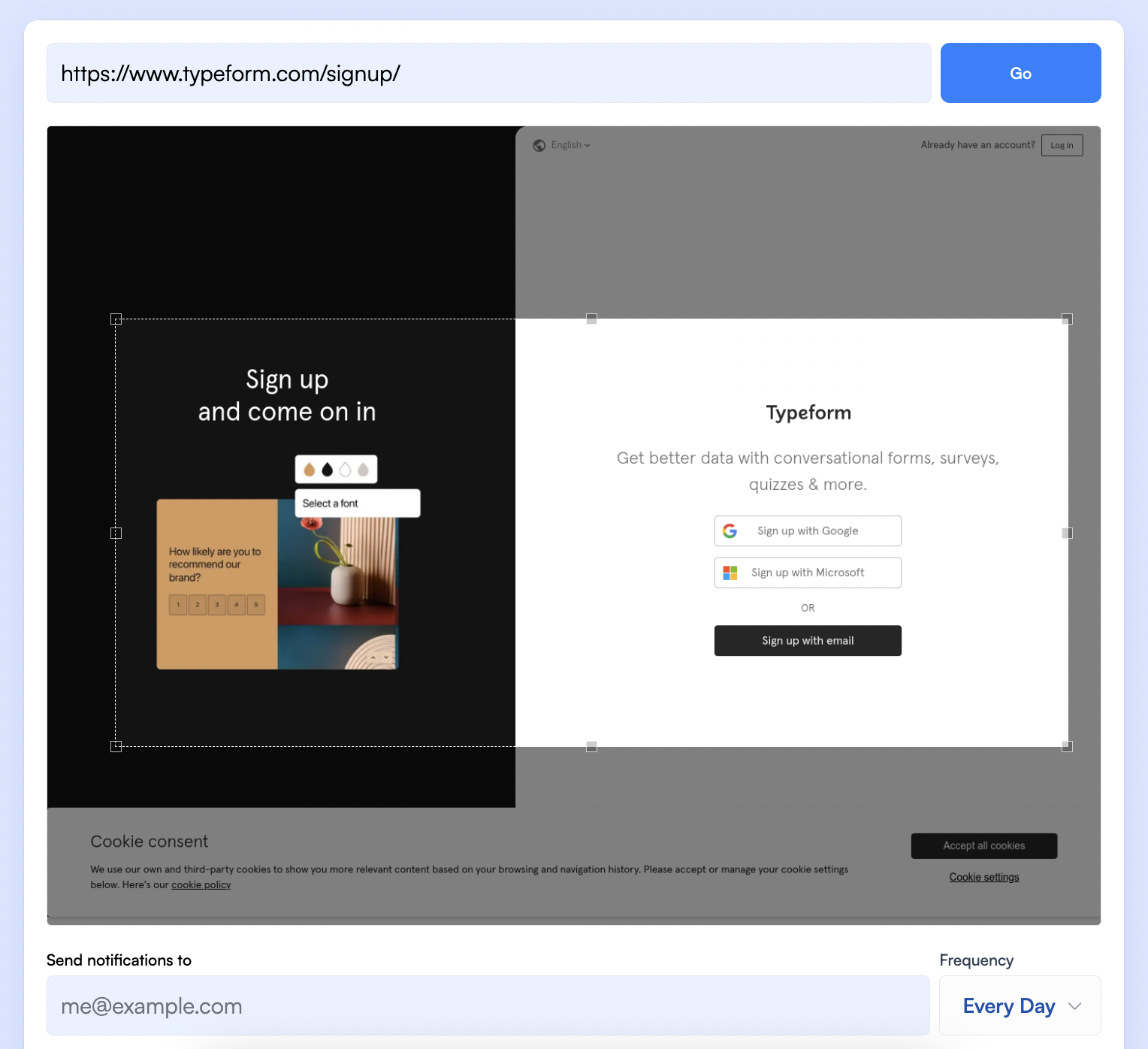
14. Promos or deals page
Especially if you're in Ecommerce, it's generally pretty easy to locate a page or category listing that features your competitor's latest promotions. Monitor this page to get a sense for the products they're trying to sell off.
15. Help center home page
If your competitor has a knowledge base or help center, you should definitely be monitoring (at least) its home page. The articles and content featured on your competitor's help center home page are a great source of intel about the things they want their customers to do with their products (for example, activate a certain feature).
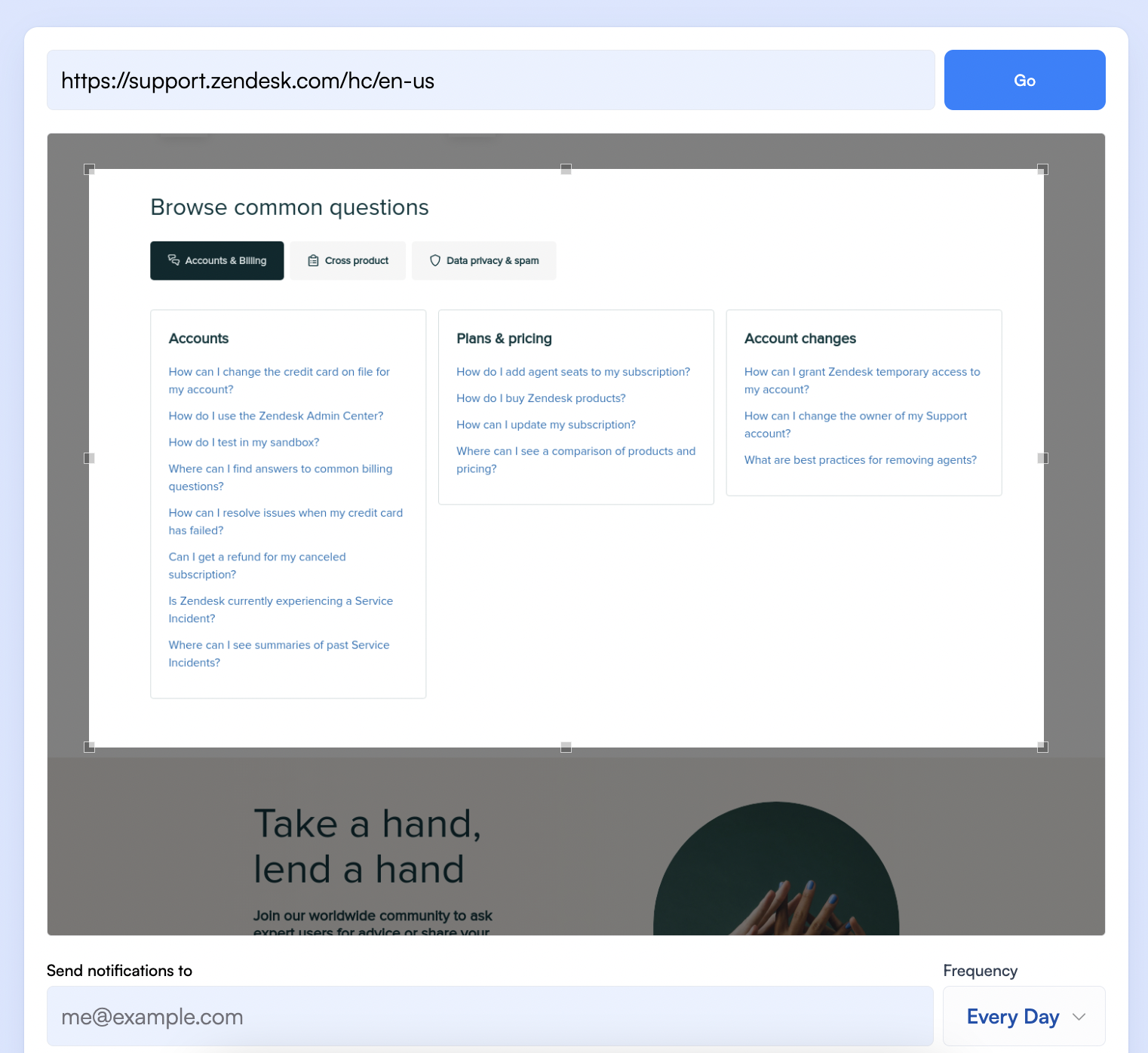
16. Customer community or feature request board
Your competitors may have a customer community or forum where people can discuss the competitor's products, submit issues, or request improvements. This is an excellent source to learn about what your competitor's customers like and dislike about your competitor. Some software companies even publish their roadmap for all to see!
17. Terms & conditions page
It never hurts to watch your competitor's privacy policy and terms and conditions web pages. You might learn a thing or two as their service level agreements change.
Next, we'll cover some sources you should be monitoring on third-party websites to help you gather even more competitive intelligence:
18. Downdetector
Downdetector is a website that "detects" when a company is experiencing uptime issues based on user self-reporting. If your competitor has a page here, monitor it for insights that you might not be able to get from their status page.
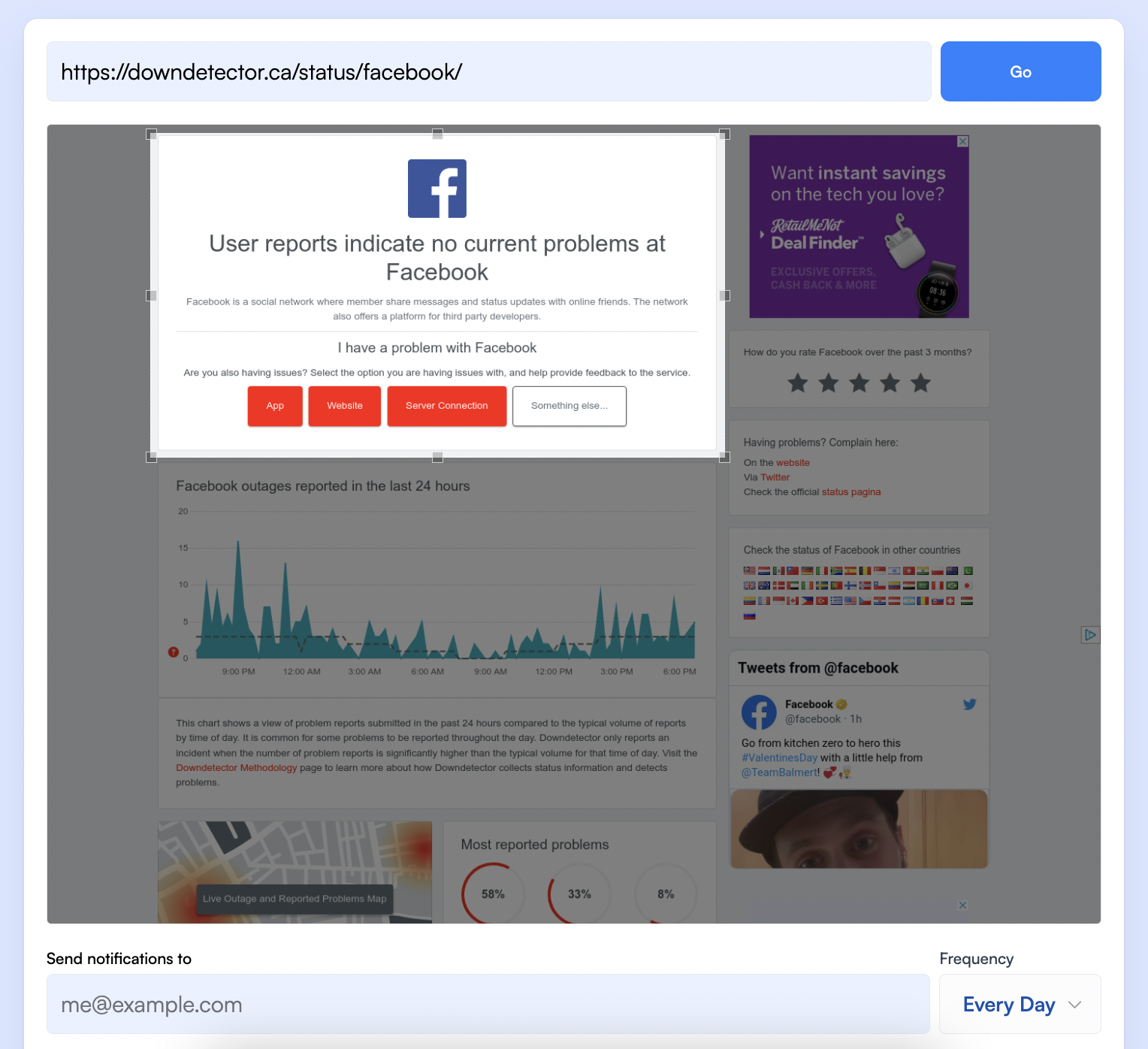
19. 3rd-party reviews
Monitor any third-party review sites that your competitor is listed in. You can usually find a way to pull up a list of the most recent reviews; monitoring this list will keep you in the loop as positive or negative reviews are posted. This is another great source to learn what customers really think about your competitors.
20. Social media bio/background image
You can definitely use Visualping to monitor social media posts, but I also advise that you monitor competitor profile bios and background images. In my experience, these elements are kind of like their home page, and only change when there's some real intention behind it. Detecting this change can reveal a lot about how a competitor wants to position themselves.
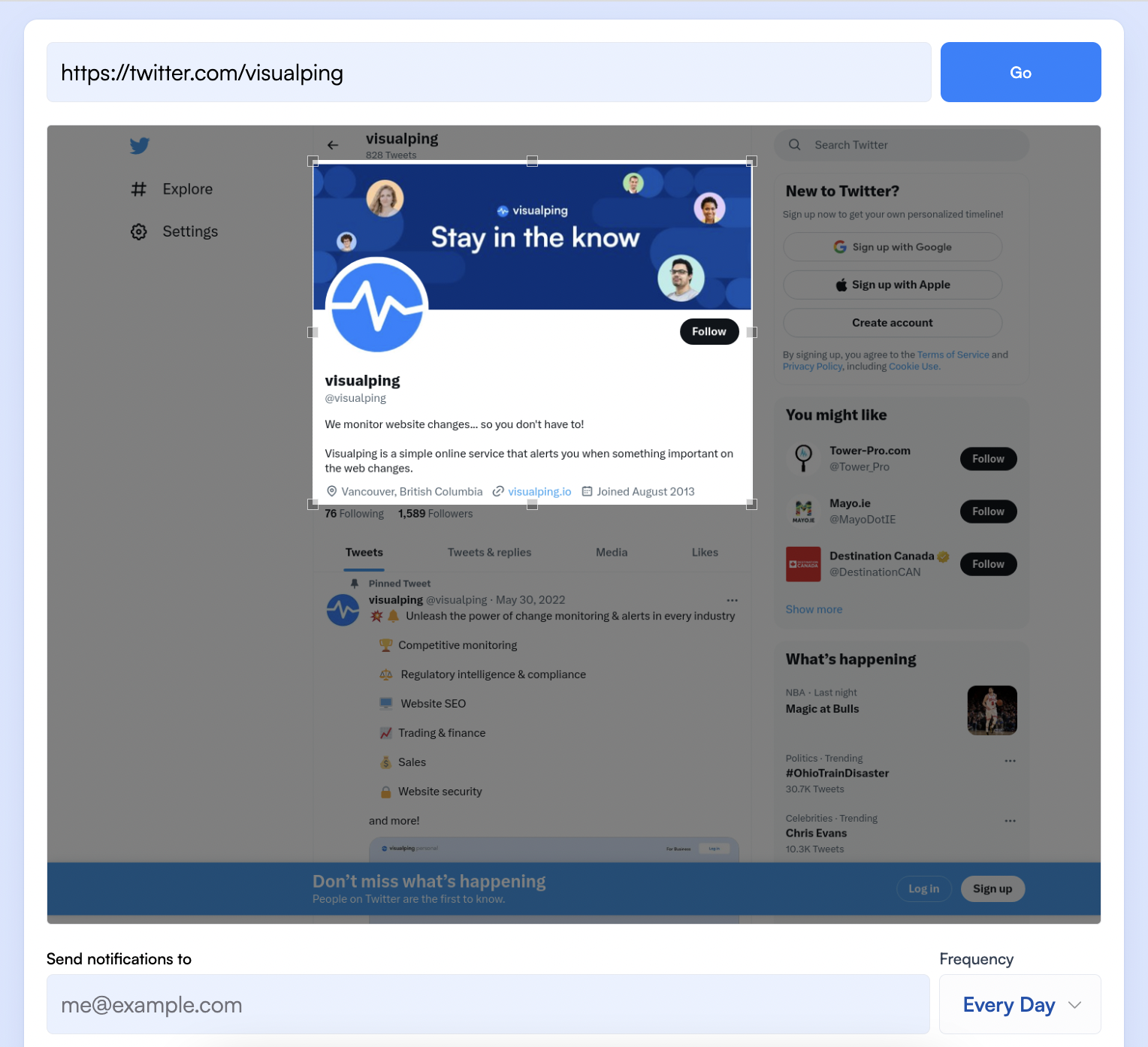
21. Google News
Your competitor's press release page will only tell you what they want you to know. Monitor the Google News search results for your competitor's brand to get quick insights into what the media is saying.
22. Youtube/Vimeo
Monitor YouTube and Vimeo search result pages for your competitor's brand name. You would be surprised at a) the amount of third-party content that shows up on YouTube, and b) the amount of first-party content that is on Vimeo, especially for B2B (a lot of agencies use Vimeo). One time, I found a competitor's internal marketing strategy meeting posted by a consultant on Vimeo - it had been posted with the wrong visibility settings.
23. Wikipedia page
Wikipedia can provide a wealth of information about your competitors, including company history, products and services, organizational structure, and notable events. It can also highlight any controversies or criticism the company has faced. This is a great use case for Visualping's text mode, which will show you textual, rather than visual changes; and can be configured to notify you if a certain keyword is added or removed.
24. Crunchbase profile
Crunchbase is a platform that provides information on startups and companies, including funding rounds, investors, leadership, and more. By monitoring your competitors' Crunchbase profiles, you can gain insights into their financial health, growth trajectory, and potential partnerships or acquisitions.
25. App store listings
If your competitors have apps, monitoring their app store listings can provide valuable information on their user base, new features, user reviews, and overall app performance.
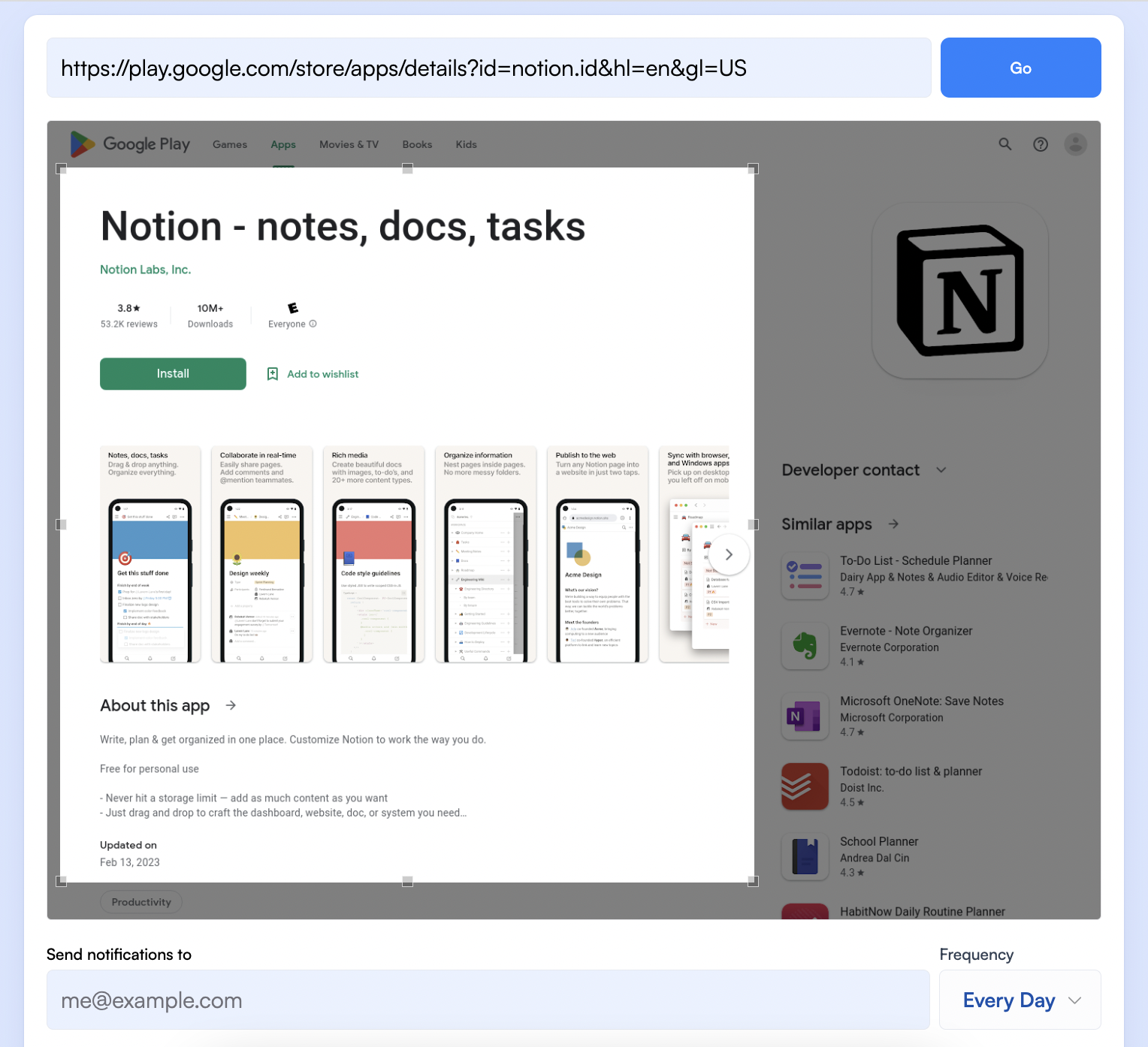
26. "Vs" or competitor pages
Pages found on comparison websites or even on your competitors' own websites provide a direct comparison of your product or service and your competitors'. Monitor these pages to understand how the market - and your competitors - say you stack up.
27. Ad Library pages
Your competitors ads on social platforms such as Facebook, Instagram, Tiktok, and Google are available for anyone to view and see what ads are live. These ad libraries are a treasure trove of information, as you can see when competitors launch new ads, revise or re-launch existing ads, or even turn off ads.
This can be very beneficial to get a sense of what your competitors are running during competitive holidays or sales events. Consider an e-commerce store that's monitoring the competitions Black Friday ads the moment they go live; this intelligence will help you understand how they're positioning their product, what pricing promotions they're offering, and what creatives they're using.
How to Set Up Competitive Intelligence Monitoring with Visualping
Step 1: Copy the URL you want to monitor, then paste it into the search field on Visualping’s homepage
The first thing to do if you want to be notified when your competitor updates a page is to get the URL for the page you want to track. Then, simply go to Visualping’s homepage and paste it in to start the process.
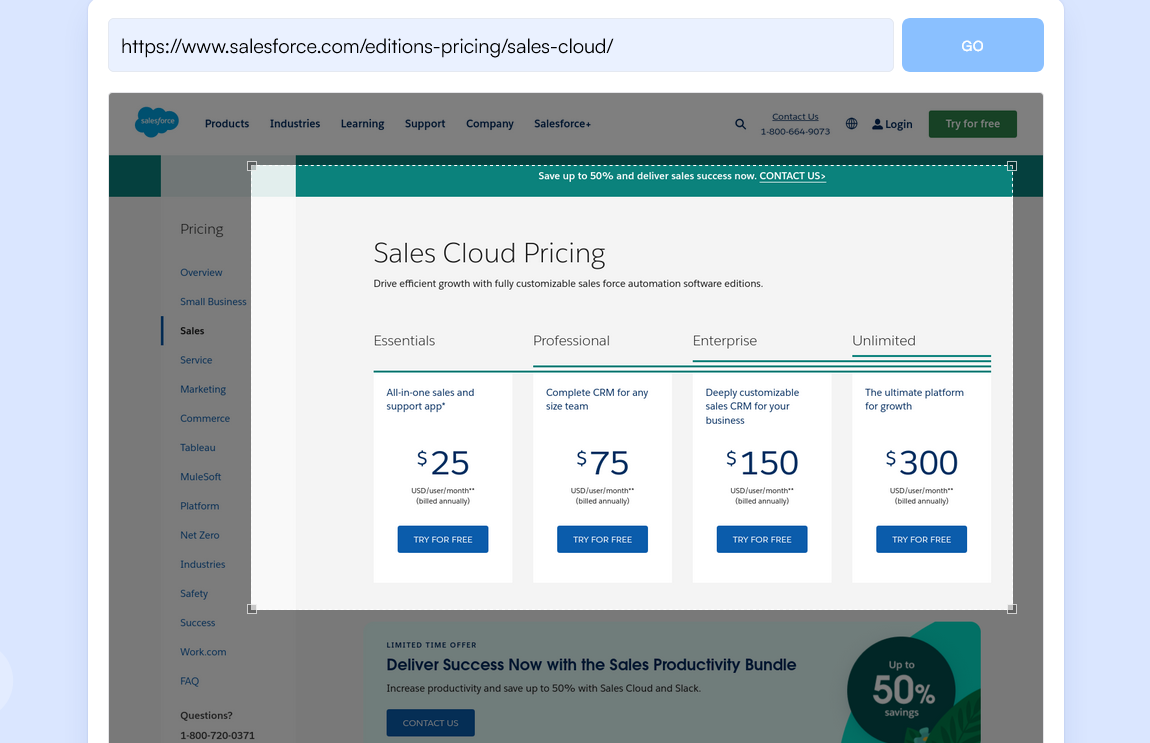
Step 2: Decide how often you want Visualping to check the page for changes
Next, you must decide how often you want to check the web page for changes. Choosing a higher frequency will make sure you get notified as soon as possible whenever changes occur.
Step 3: Create a Custom AI Prompt for Targeted Monitoring
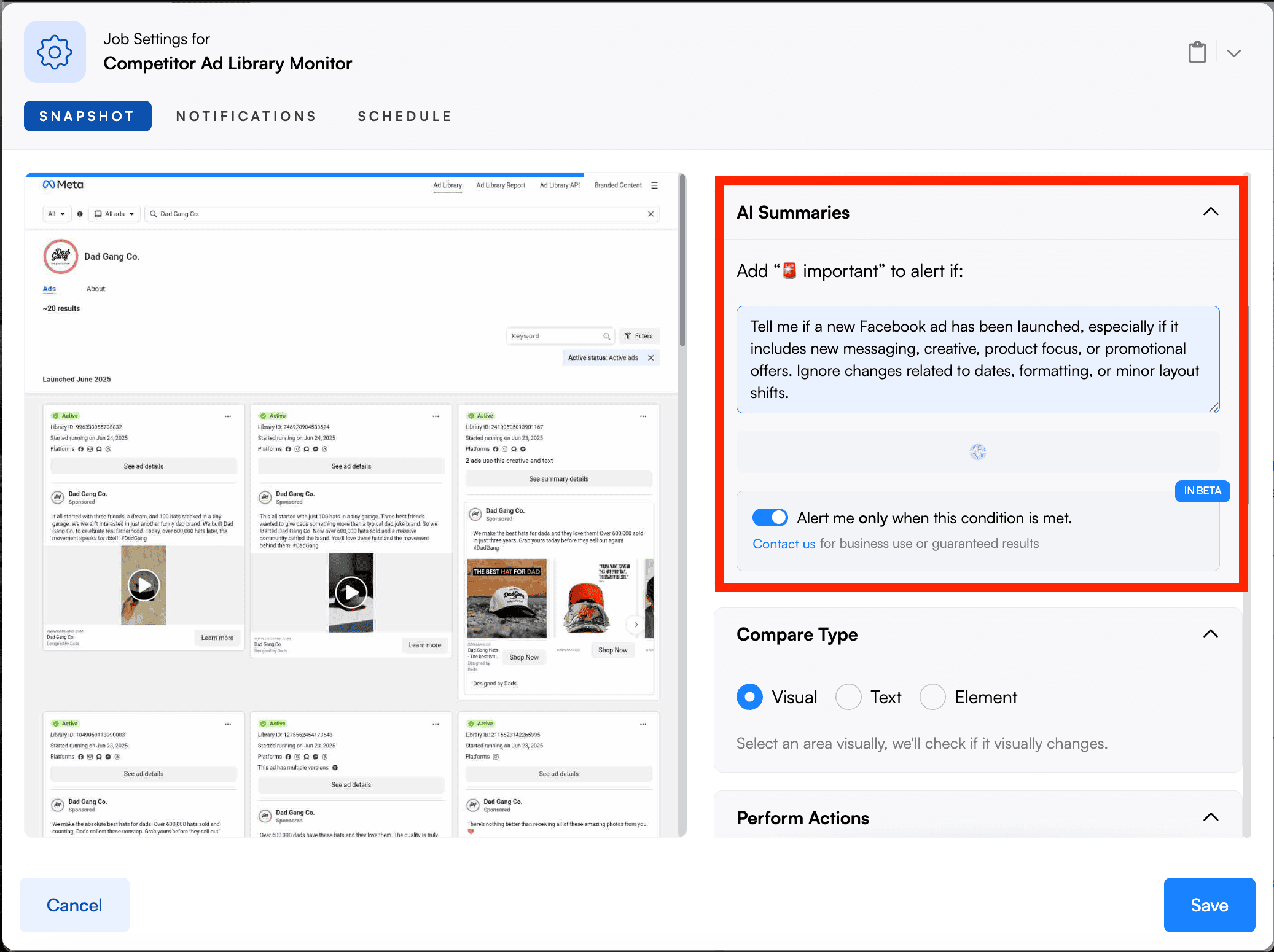
Configure Visualping's AI by entering specific instructions about what changes matter most. This prompt helps the system focus on relevant updates while filtering out minor modifications.
Example prompts include:
"Notify me about pricing changes only" "Alert me when new products are added" "Watch for changes to contact information"
Users can also enable alert filtering to receive notifications only when changes match their specified criteria. This prevents unnecessary alerts about irrelevant page updates.
Adding a prompt to tell Visualping what is important about the pages you're monitoring will allow you to get better summarizations of any changes your competitors make.
For example, you might ask Visualping to only notify you when there is a Price drop on a competitors product, versus getting notifications on something such as a new contact form being added to the page.
Step 4: Enter the email address that you want to receive alerts
Now that you’ve told Visualping what to track and how often, you need to provide an email so you can receive notifications whenever the content is updated. Make sure to provide a valid email that you have access to so that you don’t miss a thing.
Step 5: Check your email to finish creating your new account
Finally, go to the email inbox you provided and open the verification message that Visualping sent you. It will take you to your Visualping, where you can confirm your email and activate your account.
Happy monitoring!
Frequently Asked Questions
What Techniques Are Used to Gather Competitive Marketing Intelligence?
Organizations employ multiple techniques to collect competitive marketing intelligence data. Primary research methods include conducting customer surveys, interviewing industry experts, and attending trade shows where competitors present their offerings.
Secondary research approaches involve analyzing publicly available information. Companies examine competitor websites, press releases, and marketing materials to understand positioning strategies. Social media monitoring tools track competitor content and engagement patterns across platforms.
Financial statement analysis provides insights into competitor performance and investment priorities. Patent databases reveal innovation pipelines and future product directions.
Digital intelligence tools monitor competitor online activities using tools like Visualping. These platforms track, alert, and analyze website changes, advertising campaigns, and search engine optimization strategies.
How Do Companies Analyze and Understand Market Share Data in Competitive Intelligence?
Market share analysis begins with defining the relevant market boundaries and identifying key competitors. Companies collect sales data from industry reports, government statistics, and research firms.
Calculation methods typically involve:
- Revenue-based calculations - comparing total sales across competitors
- Unit-based measurements - analyzing product quantities sold
- Customer-based metrics - examining customer acquisition and retention rates
Organizations interpret market share trends over multiple time periods. They identify growing and declining segments to understand competitive dynamics.
Geographic analysis breaks down market share by regions or territories. This reveals competitor strengths in different locations and expansion opportunities.
What Are Real-World Applications of Competitive Intelligence in Business Operations?
Companies apply competitive intelligence across various business functions. Product development teams use competitor analysis to identify feature gaps and innovation opportunities in the market.
Pricing strategies rely heavily on competitive intelligence. Organizations monitor competitor pricing changes and promotional activities to optimize their own pricing models.
Sales teams leverage competitive intelligence during client presentations. They prepare competitive battle cards that highlight advantages over rival solutions. Tools like Visualping can be used to analyze and alert you of competitor moves that might require updating your internal sales battle cards.
Marketing departments analyze competitor campaigns to identify messaging strategies and channel effectiveness. This information guides content creation and media planning decisions. The marketing teams may also be responsible for the sales enablement motions as well, working with the Sales team to make sure representatives know how to handle comparisons to the competition.
Strategic planning processes incorporate competitive intelligence to evaluate market positioning and identify partnership or acquisition targets.
What Process Steps Are Involved in Performing Competitive Intelligence Research?
The competitive intelligence analysis process follows a structured approach. Planning phase involves defining research objectives and identifying key competitors to analyze.
Data collection occurs through multiple channels simultaneously:
- Gathering public information from websites and publications
- Monitoring social media and digital marketing activities
- Analyzing financial reports and regulatory filings
- Conducting primary research through surveys or interviews
Analysis stage involves organizing collected data into meaningful insights. Analysts identify patterns, trends, and strategic implications from the information gathered.
Validation ensures data accuracy through cross-referencing multiple information sources. Teams verify findings before drawing conclusions about competitor strategies.
Reporting presents findings in actionable formats for decision makers. Reports typically include executive summaries, detailed findings, and strategic recommendations.
Ongoing Validation and Reporting is also important to make sure your intelligence efforts don't go stale. Constant monitoring of the competition for any relevant moves allows you to adjust pricing, product strategy, and sales tactics.
Why Is Competitive Intelligence Important for Strategic Business Decisions?
Competitive intelligence plays a pivotal role in strategic decision-making by providing market context for business choices. Leaders gain visibility into competitor capabilities, market positioning, and future directions.
Risk mitigation becomes possible when organizations understand competitor threats and market changes. Companies can prepare defensive strategies or pivot before competitors gain advantages.
Strategic planning improves with comprehensive competitor knowledge. Organizations make informed decisions about market entry, product launches, and resource allocation based on competitive landscape understanding.
Opportunity identification emerges from analyzing competitor weaknesses or market gaps. Companies discover unserved customer segments or underexplored geographic markets.
Investment decisions benefit from competitive intelligence insights. Organizations evaluate acquisition targets, partnership opportunities, and technology investments with better market context.
How Does Competitive Intelligence Research Support Business Expansion and Growth?
Competitive intelligence research contributes significantly to business growth by identifying expansion opportunities and market entry strategies. Companies analyze competitor performance in different markets to evaluate growth potential.
Market expansion decisions rely on understanding competitor presence and strength in target regions. Organizations assess competitive intensity before entering new geographic markets.
Product line extensions benefit from analyzing competitor offerings and customer feedback. Companies identify feature gaps or pricing opportunities in existing product categories.
Customer acquisition strategies improve through competitive intelligence research. Organizations understand competitor value propositions and develop differentiated messaging to attract customers.
Partnership identification emerges from mapping competitor relationships and ecosystem participation. Companies discover potential allies or acquisition targets through competitive landscape analysis.
Innovation priorities align with market needs when informed by competitive intelligence. Organizations focus research and development efforts on areas where competitors show weaknesses or where market demand exceeds current offerings.
Visualping: competitor monitoring made simple
Get targeted updates from the competition on autopilot. Trusted by 85% of Fortune 500 companies.
Emily Fenton
Emily is the Product Marketing Manager at Visualping. She has a degree in English Literature and a Masters in Management. When she’s not researching and writing about all things Visualping, she loves exploring new restaurants, playing guitar and petting her cats.